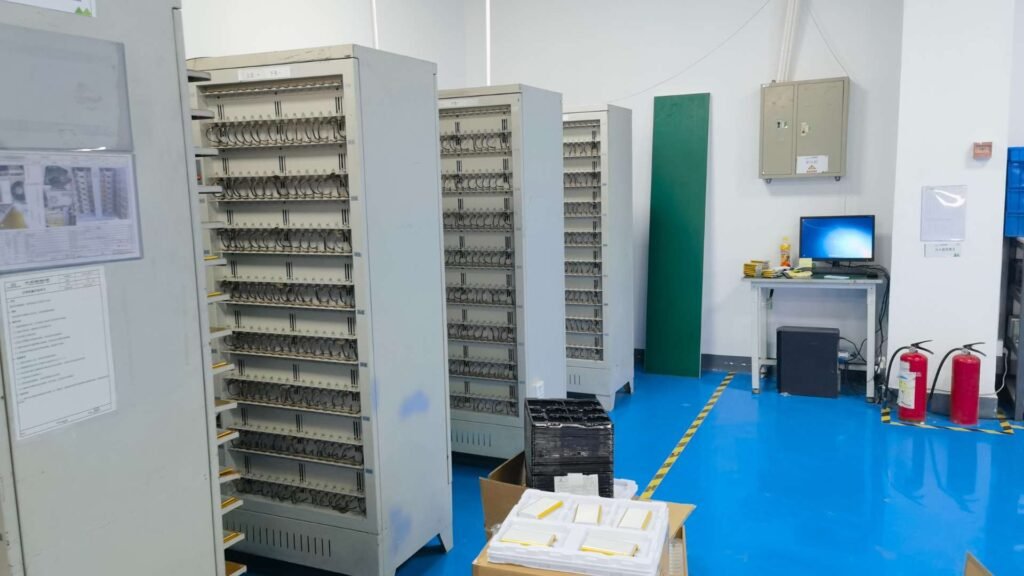1.Introduction
Assembled lithium-ion batteries need to undergo formation and aging processes to produce finished batteries. Formation is the process of charging the battery after electrolyte injection, which includes pre-formation and formation stages. Pre-formation involves a low current charge after electrolyte injection, typically accompanied by gas generation that needs to be vented for square batteries. Formation, on the other hand, involves charging the battery at a relatively higher current after pre-formation, with minimal gas generation. Aging is the process of letting the battery sit at a certain temperature after formation. Formation plays a crucial role in the post-assembly process of the battery.

2.Lithium Battery Formation Reaction
The first charge and discharge curves of the graphite negative electrode material in lithium-ion batteries do not fully overlap, as seen in the figure below. The discharge capacity, also known as reversible capacity, is usually less than the charge capacity. The difference between charge capacity and discharge capacity is termed irreversible capacity. Irreversible capacity is mainly related to the formation of the solid electrolyte interphase (SEI) membrane reaction and other side reactions. The formation of the SEI membrane corresponds to an irreversible plateau around 0.8V in the charge curve. The SEI membrane is ionically conductive but electronically insulating, and its main purpose during formation is to form a complete SEI membrane on the negative electrode surface, thereby providing the battery with stable cycling performance.
The electronic insulation of the SEI membrane prevents solvent molecules from undergoing reduction reactions on the electrode surface, preventing solvent lithiation between the graphite layers and stabilizing the carbon layer structure of the graphite electrode, thereby providing the carbon electrode with stable cycling performance. At the same time, the SEI membrane has good ionic conductivity, allowing lithium ions to freely enter and exit the SEI membrane. The structure of the SEI directly affects the battery’s cycling life, stability, self-discharge, and safety performance.
3.Pre-Formation Process of Lithium Battery
The main purpose of pre-formation is to remove the gas generated during the formation reaction and prevent battery swelling after sealing. By pre-forming and forming a uniform and stable SEI membrane, the battery exhibits stable cycling performance. The pre-formation process also affects the SEI membrane. When the current density is high, the nucleation rate is fast, leading to a loose SEI membrane structure and poor adhesion to the particle surface. Therefore, pre-formation using a low current density is conducive to the formation of a dense and stable SEI membrane.
The main principles for selecting the pre-formation system of lithium-ion batteries are as follows:
(1)The current should be as low as possible to reduce the gas formation area, improve the uniformity of formation, and reduce electrolyte loss.
(2)The cut-off voltage should not be too low or too high. When the voltage is too low, the gas cannot overflow sufficiently, leading to battery swelling after sealing. When the voltage is too high, the pre-formation time is prolonged, and the battery is prone to absorb impurities such as oxygen and water from the environment, leading to performance degradation or post-sealing swelling.
(3)Applying a certain tightening force to the cell can prevent the electrode from being pushed open and separated from the separator during gas elimination, reduce the gas formation area, and improve the uniformity of electrode pre-formation.
4.Formation Process of Lithium Battery
The main purpose of formation is to continue the formation reaction to form a complete SEI membrane. Additionally, for gas routes or bubble areas that are insufficiently pre-formed, the electrolyte continues to wet these areas during the subsequent formation process, allowing these electrode areas to continue the formation reaction, thereby making the formation degree of different parts of the electrode more uniform.
The formation current can be appropriately increased because the gas generation reaction during formation has slowed down, and the gas generation volume has decreased significantly. Increasing the current can shorten the formation time and improve the efficiency of the formation equipment.
The typical formation system of lithium-ion batteries is as follows: the pre-formation current is generally 0.02C~0.05C, and the voltage charged to the cut-off voltage of 3.4V or about 20% of the capacity after injection. The formation current is generally 0.1C, and the charging cut-off voltage is above 3.9V. The specific formation current and cut-off voltage depend on factors such as the battery model and raw materials.

5.Aging Process of Lithium Battery
Aging usually refers to the process of letting the battery sit at a certain temperature for a period to stabilize its performance, also known as seasoning. During aging, the voltage of the self-discharge battery decreases faster than that of the normal battery. Therefore, aging can also be used to screen out disqualified self-discharge batteries. Aging mainly functions by completing the formation reaction continuously, promoting gas absorption, and uniformizing the formation degree.
Aging is usually divided into room temperature aging and high-temperature aging according to the aging temperature. Room temperature aging is the aging process carried out at ambient temperature, without controlling the temperature, and is simple in process. However, due to the fluctuation of room temperature, the consistency of different batches of batteries cannot be guaranteed.
High-temperature aging is the aging process carried out at a temperature usually higher than room temperature. The advantage is that it is higher than ambient temperature, which can control the consistency of aging temperature and help ensure the consistency of different batches of batteries. Moreover, high temperature can accelerate the reaction rate of aging, allowing potential bad batteries to be exposed more quickly. However, the high-temperature process may cause a decrease in battery performance, so the specific temperature and time required for high-temperature aging need to be determined by specific experiments. Lithium-ion battery manufacturers typically use high-temperature aging temperatures between 4550 degrees Celsius for 13 days, and some manufacturers also age at room temperature for 3~4 days.
During the aging process, as time goes on, the battery voltage gradually decreases and tends to stabilize. Moreover, the higher the aging temperature, the faster the battery voltage decreases, and the shorter the time to reach stability. The voltage drop rate of the self-discharge battery is faster than that of the normal battery. The longer the aging time, the more significant the voltage difference between the self-discharge battery and the normal battery. Therefore, extending the aging time helps identify self-discharge batteries.

